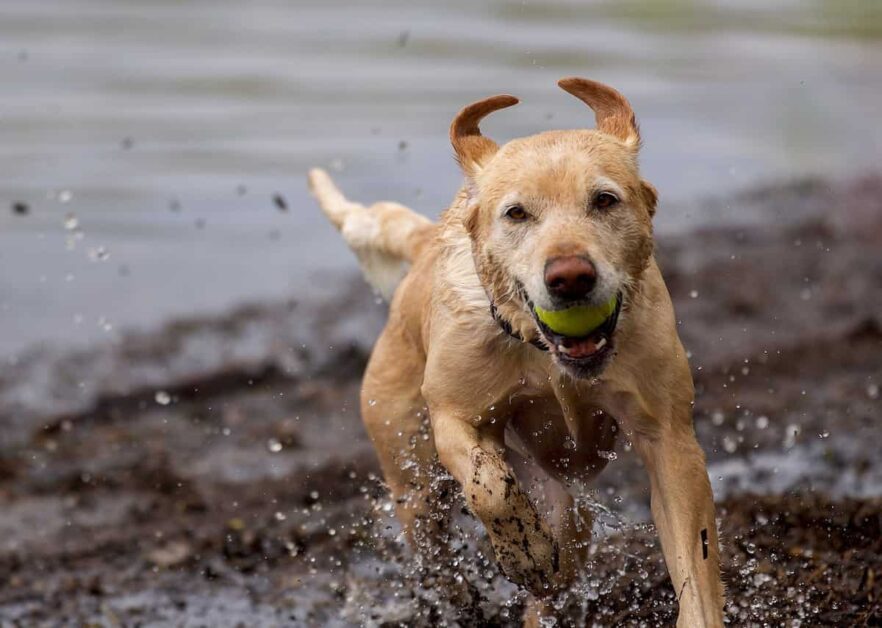Splitting dog nails underneath can be a common problem for many pet owners. It can cause discomfort to your furry friend and may even lead to infections. To ensure your dog’s well-being and contentment, you need to comprehend the origins and cures of split dog nails. This piece covers all the essential facts on split dog nails, such as precautionary steps and do-it-yourself treatments.
Symptoms of Broken or Split Dog Nails
Limping or reluctance to walk
If your dog is limping or hesitating to walk, it could be a sign of a broken or split nail. When the nail is damaged, it can cause pain and discomfort, making it difficult for your dog to walk or stand.
Bleeding or swelling
Splitting or breaking dog nails can cause bleeding or swelling around the affected area. You may also notice redness or inflammation, indicating an infection or injury.
Whimpering or licking the affected paw
Many dogs can express pain and discomfort through whimpers or licking the affected paw. It could signify an extremely painful nail split if your dog constantly licks or gnaws at the affected paw.
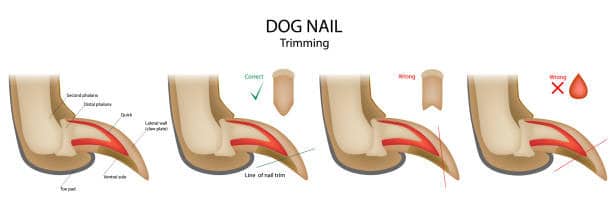
What Are The Causes of Broken or Split Dog Nails?
Now that you know the symptoms, it’s essential to understand the causes of split or broken dog nails. Some of the common causes include:
- Trauma: Trauma is the most common cause of a torn nail. Most dogs can accidentally cut their nails while rough playing, running, or walking on rough surfaces.
- Overgrown Nails: Overgrown nails can become brittle and prone to breaking or splitting. To prevent this, your pet’s nails must be trimmed regularly.
- Nutritional Deficiencies: When dogs lack essential nutrients like biotin, zinc, or essential fatty acids, their nails can become brittle and easily break.
- Infection: Infections such as fungal or bacterial infections can damage your dog’s nails, making them weak and prone to splitting.
- Age: As dogs age, their nails may weaken and become brittle, increasing the likelihood of breakage.
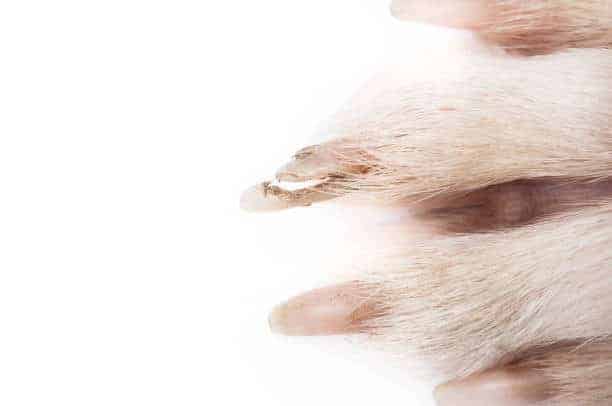
Different Types of Dog Nail Injuries
Broken Nails, Cracked, or Split Nails
Broken, cracked, or split nails are a common injury in dogs, and they can occur due to several reasons, such as:
- Running or playing on hard surfaces
- Getting caught in carpets or other materials
- Scratching excessively
- Trimming nails too short
Symptoms of broken, cracked, or split nails in dogs may include:
- Limping or favoring a paw
- Bleeding
- Swelling
- Pain when touched
- Licking their nails or chewing at the paw
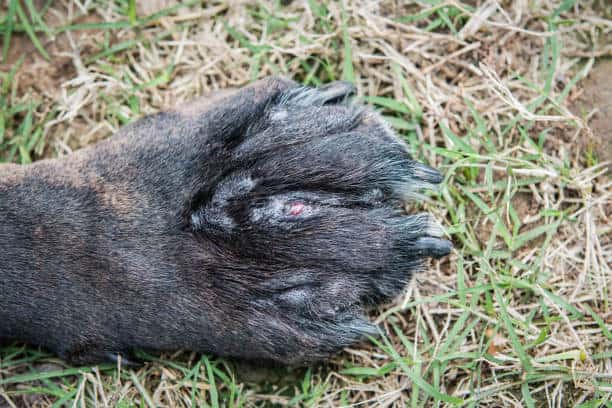
Nail Infection
Nail infection is another common nail injury in dogs, usually caused by bacteria or fungi. Dogs with long hair, such as poodles and terriers, are more prone to nail infections. Some common causes of nail infections in dogs include:
- Trauma
- Overgrown nails
- Walking on dirty or contaminated surfaces
Symptoms of nail infections in dogs may include:
- Swelling
- Redness
- Pain
- Bleeding
- Unpleasant odor
- Discharge
Dog’s Nails Ripped Off / Fell Off
When the nail is not firmly attached, they may rip or fall off. It may be painful for dogs and can be caused by several factors, including:
- Getting caught in a fence or other sharp objects
- Trauma from being hit by a car or falling from a height
- Infections
- Tumors
Symptoms of ripped or fallen-off nails in dogs may include:
- Pain
- Bleeding
- Swelling
- Limping or favoring a paw
- Excessive licking or chewing at the paw
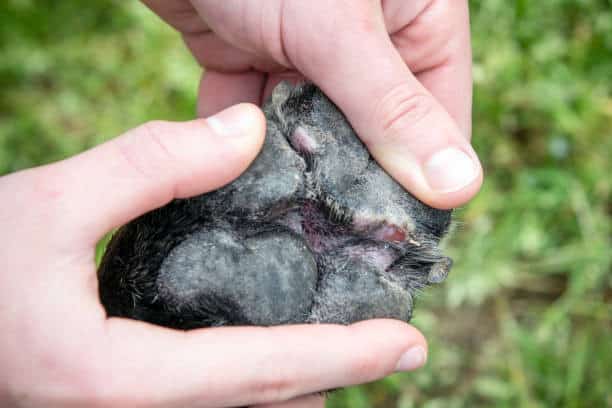
Broken Dew Clawz
A broken dew claw is a common injury in dogs, especially those with longer dew claws. A dew claw is found on the inner side of the paw, and they are not used when the dog walks. Causes of broken dew claws include:
- Catching on objects
- Playing too roughly
- Trimming too short
Symptoms of broken dog’s toenails may include:
- Pain
- Bleeding
- Swelling
- Limping or favoring a paw
- Refusal to walk on hard surfaces
Overgrown Nail
Overgrown nails are a common problem in dogs. They can cause significant discomfort and pain. Causes of overgrown nails include:
- Lack of exercise
- Not trimming nails regularly
- Improper diet
Symptoms of overgrown nails in dogs may include:
- Pain when walking or running
- Nail curling under the paw
- Difficulty walking on hard surfaces
- Secondary infections
Brittle Nails
Brittle nails are commonly seen in older dogs. Causes of brittle nails in dogs include:
- Aging
- Poor diet
- Lack of exercise
Symptoms of brittle nails in dogs may include:
- Cracking or split vertically
- Nail breaks easily
- Pain when touched
How do You Diagnose Dog Nail Disorders?
Veterinary Visits
Regular vet visits are crucial for diagnosing a dog nail disorder. During your dog’s vet visit, examine their paws and nails for potential issues. Remember these tips when scheduling a visit:
- Look for signs of nail problems, such as limping, bleeding, or an unusual gait.
- Inform your veterinarian if your dog has been excessively licking or chewing their paws.
- Ask the veterinary community how to maintain your dog’s foot and prevent future problems.
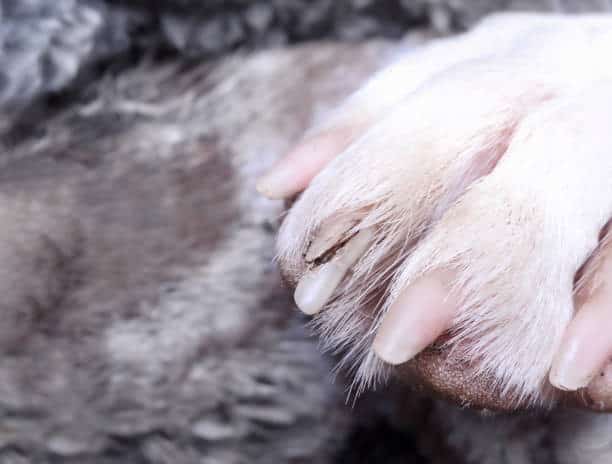
Immune-Mediated Diseases
Immune-mediated diseases can affect a dog’s nails and cause various nail disorders. These diseases occur when the dog’s immune system attacks healthy cells, including the nails. The following are some of the immune-mediated conditions that can affect a dog’s nails:
- Lupoid onychodystrophy
- Pemphigus
- Vasculitis
Some signs of immune-mediated diseases, like lupoid onychodystrophy include:
- Cracked or brittle nails
- Nail loss
- Inflammation or swelling around the nails
- Pain or discomfort when walking
Treatment for immune-mediated diseases, like lupoid onychodystrophy will depend on the specific condition and may include medications to suppress the immune system or topical treatments to manage symptoms.
Bacterial Claw Infections
Bacterial infections can also cause nail disorders in dogs. These infections occur when bacteria enter the exposed nail bed through a cut or are exposed quickly. The following are some common signs of bacterial claw infections:
- Swelling or redness around the nail
- Pain or discomfort when touched
- Discharge or pus from the nail
- Changes in nail color or texture
Treatment for bacterial claw infections usually involves antibiotics to clear the infection. The vet may also recommend cleaning the affected toenail and keeping it dry to prevent infection.
Here’s How To Treat Broken or Split Dog Nails
Trim Nails Regularly
Trimming your dog’s nails regularly is one of the best ways to prevent split or broken nails. Long nails are more prone to breakage and splitting, so cut them every 2-3 weeks.
Fish Oil and Biotin Supplements
Fish oil and biotin supplements can help improve your dog’s nail health. These supplements help strengthen your dog’s nails and reduce the risk of breakage or splitting.
Quality Dog Food
A well-balanced diet can also help keep your dog’s nails healthy. Ensure your dog gets high-quality dog food with essential vitamins and minerals.
Checks for Nail Health
Regularly checking your dog’s nails for any signs of damage or fungal infections can help catch any issues early. Look for redness, swelling, or discharge around the nail area.
Home Treatments
If your dog has a split or broken nail, you can try home treatments such as using a styptic pencil or powder or baking powder to stop bleeding. You can soak the affected paw in warm water or apply a protective covering to the nail.
Veterinary Care
If your dog’s broken or torn nail is severe, it’s best to take them to a veterinary hospital. Your vet can clean the affected area, prescribe medication if necessary, and provide professional nail trimming services. They may also provide a referral to a veterinary dermatologist referral, who can effectively treat the nail disorders.
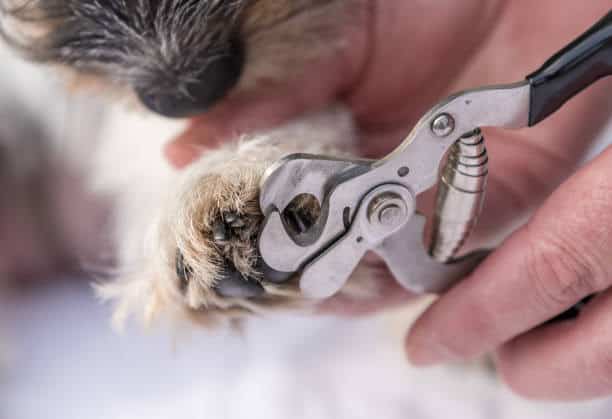
What to Do if a Dog’s Nail is Coming Off?
First Aid for Broken Nails
- Keep your dog calm and prevent them from licking the wound.
- Examine the nail to determine the extent of the damage.
- Applying pressure on the affected area to stop bleeding.
- Clean the wound with saline solution and apply an antibiotic ointment.
- Bandage the affected area to prevent dirt and debris from entering the wound.
Emergency Vet Care
Visiting a vet immediately is essential if the nail is completely torn or the bleeding doesn’t stop. Your vet will provide the required first aid. They may also prescribe pain medication or advise an X-ray to check for further damage.
How to Protect And Nurture Your Dog’s Nail Health?
Regular Grooming
To maintain your dog’s nail health, it’s crucial to trim their nails every 2-4 weeks based on their growth rate. Use the right tools when trimming your dog’s nails to avoid causing bleeding and pain by cutting into the blood vessels. A professional groomer can also help you in this regard.
Exercise and Play
More active dogs tend to have short nails since the constant running and jumping help wear down their nails naturally. Encourage your dog to exercise and play to keep their nails healthy.
Select Appropriate Surfaces
Avoid walking your dog on rough surfaces, which can cause excessive wear and tear on their nails. Instead, opt for gentler grassy or sandy surfaces on their paws and nails.
FAQ
Is it normal for dogs’ nails to split?
No, it is not normal for a dog’s nails to split. Splitting nails can be caused by underlying health conditions or poor nutrition.
How do you fix a dog’s split nail?
If it is a minor injury, you can clip off the damaged part and file the nail smoothly using a Dremel tool. If there are serious problems, consult your vet for professional treatment.
Will a dog’s split nail heal on its own?
Sometimes, a split nail can heal on its own, but it may take weeks or months. However, seeking veterinary care to prevent infection and discomfort is best.
Why is my dog’s nails splitting?
Various factors, including a poor diet, trauma, overgrown nails, or underlying health issues, can cause dog nail splitting.
How do I stop my dogs nails from splitting?
To prevent nail splitting, maintain your dog’s nails with regular trimming, ensure a balanced diet rich in vitamins and minerals, and avoid harsh surfaces.
How do you treat brittle nails in dogs?
Treating brittle nails in dogs involves providing a healthy diet, avoiding harsh surfaces, cauterizing powder, and using paw balm to moisturize the nails.
Is it OK if dogs nail falls off?
If a dog’s nail falls off, it’s usually not a cause for concern. The nail will regrow eventually, but keep the area clean to prevent infection.
How long does a dog’s broken nail take to fall off?
A dog’s broken nail can take several weeks to fall off entirely. During this time, keep the nail bed clean and monitor for any signs of infection.
What is brittle nail disease in dogs?
Brittle nail disease in most dogs is when the nails become weak, thin, and prone to splitting. Various factors, including malnutrition, hormonal imbalances, and autoimmune diseases, can cause it.
Author Profile
- Site Owner And Planning Specialist
-
Aritra, the founder of Labradorandyou.com, is a lifelong dog lover whose passion ignited for Labradors for their loyalty and intelligence. With extensive research and personal experiences, Aritra has become a Labrador expert, offering a rich resource on the breed. Labradorandyou.com provides reliable, timely, and evidence-based information, including Labrador-specific product reviews, training techniques, and care tips.
Labradorandyou.com was born out of Aritra's passion and his desire to share his profound knowledge about the breed. The site serves as a comprehensive resource, offering a wealth of up-to-date information for Labrador owners and enthusiasts alike
Also by the author
-
 FAQNovember 17, 2023How To Adopt An Emotional Support Dog?
FAQNovember 17, 2023How To Adopt An Emotional Support Dog?
-
 Mix-BreedsNovember 16, 2023Red Labradoodle Ultimate Guide: Breed Facts, Care Tips
Mix-BreedsNovember 16, 2023Red Labradoodle Ultimate Guide: Breed Facts, Care Tips
-
 Top BreedersNovember 8, 2023Breeding Labradors: Everything You Need to Know
Top BreedersNovember 8, 2023Breeding Labradors: Everything You Need to Know
-
 FAQOctober 17, 2023Do Dogs Like Music? Researchers Say Yes! Find Out
FAQOctober 17, 2023Do Dogs Like Music? Researchers Say Yes! Find Out
